I am trying to fit data with an admittance equation for an rlc circuit having 6 components. I am following an example given he[fit]1re and inserted my equation. The equation is the real part of admittance for the 6 component circuit simplified using Mathcad. In the figure attached the x axis is omega (w=2*pi*f) and y is admittance in milli Siemens.
The program runs but it doesn't do the fitting despite a good trial function. I appreciate any help why the fit is a straight line. I attached also a Gaussian fitting example.

this is what i get when I try to fit with the equation. The data is the one with a smaller peak on the left and the trial function is the dotted line. the fit is a straight line
from numpy import sqrt, pi, exp, linspace, loadtxt
from lmfit import Model
import matplotlib.pyplot as plt
data = loadtxt("C:/Users/susu/circuit_eq_real5.dat")
x = data[:, 0]
y = data[:, 1]
def circuit(x,C0,Cm,Lm,Rm,R0,Rs):
return ((C0**2*Cm**2*Lm**2*R0*x**4)+(Rs*C0**2*Cm**2*Lm**2*x**4)+(C0**2*Cm**2*R0**2*Rm*x**2)+(Rs*C0**2*Cm**2*R0**2*x**2)+(C0**2*Cm**2*R0*Rm**2*x**2)+(2*Rs*C0**2*Cm**2*R0*Rm*x**2)+(Rs*C0**2*Cm**2*Rm**2*x**2)-(2*C0**2*Cm*Lm*R0*x**2)-(2*Rs*C0**2*Cm*Lm*x**2)+(C0**2*R0)+(Rs*C0**2)-(2*Rs*C0*Cm**2*Lm*x**2)+(2*Rs*C0*Cm)+(Cm**2*Rm)+(Rs*Cm**2))/((C0**2*Cm**2*Lm**2*x**4)+(C0**2*Cm**2*R0**2*x**2)+(2*C0**2*Cm**2*R0*Rm*x**2)+(C0**2*Cm**2*Rm**2*x**2)-(2*C0**2*Cm*Lm*x**2)+(C0**2)-(2*C0*Cm**2*Lm*x**2)+(2*C0*Cm)+(Cm**2))
gmodel = Model(circuit)
result = gmodel.fit(y, x=x, C0=1.0408*10**(-12), Cm=5.953*10**(-14),
Lm=1.475*10**(-7), Rm=1.571, R0=2.44088, Rs=0.42)
print(result.fit_report())
plt.plot(x, y, 'bo')
plt.plot(x, result.init_fit, 'k--')
plt.plot(x, result.best_fit, 'r-')
plt.show()
Below is the Fit Report
[[Fit Statistics]]
# fitting method = leastsq
# function evals = 14005
# data points = 237
# variables = 6
chi-square = 32134074.5
reduced chi-square = 139108.548
Akaike info crit = 2812.71607
Bayesian info crit = 2833.52443
[[Variables]]
C0: -7.5344e-15 +/- 6.3081e-09 (83723736.65%) (init = 1.0408e-12)
Cm: -8.9529e-13 +/- 1.4518e-06 (162164237.47%) (init = 5.953e-14)
Lm: 2.4263e-06 +/- 1.94051104 (79978205.20%) (init = 1.475e-07)
Rm: -557.974399 +/- 1.3689e+09 (245334051.75%) (init = 1.571)
R0: -5178.53517 +/- 6.7885e+08 (13108904.45%) (init = 2.44088)
Rs: 2697.67659 +/- 7.3197e+08 (27133477.70%) (init = 0.42)
[[Correlations]] (unreported correlations are < 0.100)
C(R0, Rs) = -1.003
C(Rm, Rs) = -0.987
C(Rm, R0) = 0.973
C(C0, Lm) = 0.952
C(C0, Cm) = -0.502
C(Cm, R0) = -0.483
C(Cm, Rs) = 0.453
C(Cm, Rm) = -0.388
C(Cm, Lm) = -0.349
C(C0, R0) = 0.310
C(C0, Rs) = -0.248
C(C0, Rm) = 0.148
Thank you so much M Newville and Mikuszefski and others for your insights and feedback. I agreed what I put there is perhaps a mess to put in a program. It is apparent from the python code that I am not versed in Python or programming.
Mikuszefsky, thanks for posting the rlc example code. Your approach is neat and interesting. I didn't know Python does direct complex fitting.I will try your approach and see if can do the fit. I want to fit both the real and imaginary part of Y (admittance). I will definitely get stuck somewhere and will post my progress here. Best, Susu

